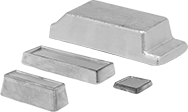Casting Metals

Melt and pour these alloys into molds to create metal parts and prototypes.
Lead can be used for caulking, castings, and hot-dipped coatings.
Lead-base coppered babbitt is able to withstand shock and vibration and requires less lubrication than other types of babbitt. Use it to cast bearings for low-speed, heavy-load applications.
Lead
Approximate | |||||||||
|---|---|---|---|---|---|---|---|---|---|
| Melting Temperature, °F | Material Composition, Lead | Thick. | Wd. | Lg. | Wt., lbs. | Specifications Met | Each | ||
| 621° | 99.9% | 1" | 2" | 8 3/4" | 5 | Ingot | ASTM B29 | 000000 | 000000 |
Lead-Base Coppered Babbitt
Material Composition | Approximate | ||||||||||
|---|---|---|---|---|---|---|---|---|---|---|---|
| Melting Temperature, °F | Lead | Tin | Antimony | Copper | Arsenic | Thick. | Dia. | Wt., lbs. | Each | ||
| 625° | 75% | 10% | 14% | 0.3% | 0.5% | 1 1/2" | 3 3/4" | 4 1/2 | Rod and Disc | 0000000 | 0000000 |

























